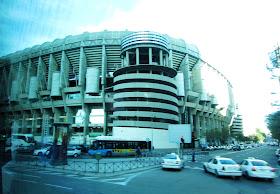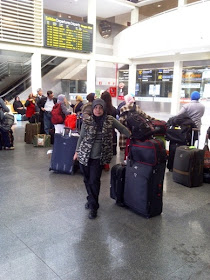"Ninety-nine percent of the failures comes from people who have the habit of making excuses..." - George W Carve
.JPG) |
| (A painting of Toledo) |
MADRID – TOLEDO – CORDOBA
Today we were joined by a family of 8 for the rest of our tour until Fez where they will split to go on a different route. After a hearty breakfast, we checked out and headed towards Toledo, the capital of Castilla la Mancha.
 |
| (El Alcazar of Toledo) |
Toledo was the capital of the Spanish Crown until 1563. The city is famous for its rich history and for the coexistence of the Christian, Islamic and Jewish cultures. In the Middle Ages, Toledo was the European capital for the study of languages and natural sciences. Today it is a major tourist attraction, especially famous for one of its constructions - 'El Alcazar'.
 |
| (A street in Toledo) |
We were met by our local tour guide and we had a walking tour to Santo Tome Church. The church dates from the 12th century, although it was completely rebuilt in the early 14th century by the Count of Orgaz. The tower is one of the best examples of the Mudéjar art characteristic of Toledo. The two upper sections are made of brick, with two groups of two and three windows with pointed horseshoe arches scalloped with other lobed arches. The interior is home to one of El Greco’s most famous paintings, the Burial of the Count of Orgaz, which is on display in a special room.
 |
| (A group photo at Santo Tome Church) |
We visited the Damascene Steel Workshop a typical metal gold art craft centre. Toledo steel was famed for its very high quality alloy, whereas Damascene steel, a competitor from the Middle Ages on, was famed for a specific metal-working technique. We bought some souvenirs of knives and mini swords made of the famous Toledo steel.
 |
| (The Damascene Steel Workshop) |
As we have to move out of Toledo by 1230, we packed chicken sandwiches to be eaten on the bus. The bus stopped at one R&R along the way for toilet, coffee stop and prayers.
.JPG) |
| (Arriving in Cordoba in late afternoon) |
We reached Cordoba around 1700 and it was already dark. As there will be a general strike nationwide tomorrow, the tour of Cordoba was cramped to today. We visited Santa Iglesia Cathedral Cordoba, situated in the old Medina. The Cathedral is a former Islamic mosque (mezquita) but since 1236 it was converted into a Catholic Christian cathedral.
 |
| (Santa Iglesia Cathedral) |
The Mezquita is regarded as one of the most accomplished monuments of Islamic architecture. Since the early '20s, Spanish Muslims have lobbied the Roman Catholic Church to allow them to pray in the cathedral but the campaign has been rejected by both Spanish Catholic authorities, and the Vatican.
 |
| (Formerly a mosque) |
Nearby is the Medina Azahara, the ruins of a vast, fortified Arab Muslim medieval palace-city built by Abd-ar-Rahman III al-Nasir, Ummayad Caliph of Córdoba. It was an Arab Muslim medieval town and the de facto capital of al-Andalus, or Muslim Spain, as the heart of the administration and government was within its walls.
 |
| (Arab Muslim medieval palace) |
We couldn't continue the walking tour of the old city as there were a few mishaps of missing persons, a daughter was left in the bus and a person loss his way when he broke off from the group to take pictures of the old medina.
 |
| (The bridge to the old Medina) |
We had a Moroccan dinner while waiting for the team leader to sort things out and get the group together again. Later we checked in the Cordoba Ayre Hotel late night and had a good night rest.
 |
| (The tea maker) |
.JPG)


.JPG)




.JPG)




.JPG)





.JPG)












.JPG)




.JPG)






.JPG)





